-
 What is Glue?
What is Glue? - Definition from the Merriam-Webster Dictionary:
- 1 a: any of various strong adhesive substances ; especially : a hard protein chiefly gelatinous substance that absorbs water to form a viscous solution with strong adhesive properties and that is obtained by cooking down collagenous materials (as hides or bones) b: a solution of glue used for sticking things together
- Hm – not what I am looking for, if you need it, you can buy it here – end of story.
- 2 something that binds together <enough social glue…to satisfy the human desire for community — E. D. Hirsch, Jr.>
-
Social Glue … now we’re getting closer. So again, what is Glue? There are several companies in the software business with
goo-yglue-y products:Glue is Companies and Products
AdaptiveBlue has a browser extension called Glue. (Blue Glue?
 ) VC and Blogger Fred Wilson aptly calls it A Social Net That Lives In Your Browser.
) VC and Blogger Fred Wilson aptly calls it A Social Net That Lives In Your Browser. Then there is Yahoo Glue. And of course there are a bunch of companies that don’t call themselves or their products Glue – they just do it.
Gnip’s mission is elegantly “Making data portability suck less”. Here’s an easy (?) chart explaining what they do:

Boomi is another Glue company, providing integration Platform-as-a-Service (iPaaS – ah, starting 5-letter acronyms
 ). Read their thought-provoking post on Why APIs Don’t Solve the SaaS Integration Challenge.
). Read their thought-provoking post on Why APIs Don’t Solve the SaaS Integration Challenge. MindTouch started their life as a wiki company, and grew into “an open source enterprise collaboration and community platform that enables users to connect and remix enterprise systems, social tools and web services.”. Ouch, that sounds so official – here’s another version from the Chief Conductor who just returned from a major Product Launch:
We do orchestration for a myriad of systems, databases and any web service, all with a easy to use wiki-like interface.
Let’s not forget about Mashery, plumbers of the Web, or more elegantly, a “leading provider of API management services enabling companies to easily leverage web services as a distribution channel.”
The list can go on and on, and even in the current downturn we will see more Glue companies. In fact Glue has become investment theme for some really smart VCs:
Glue is our term for the web infrastructure layer that facilitates the connections between web services and content companies
Glue is a Concept – actually, several concepts
- Enterprise Glue: A "web oriented architecture" and beyond SOA
- Data Glue: Mash-ups, mash-ups and more mash-ups
- Social Network Glue: The movement toward cross-network interoperability and data sharing
- Interface Glue: Cross-platform, cross-browser technologies like Silverlight and Adobe Air
- Messaging Glue: Tools that are evolving for meta-messaging
- Identity Glue: Reputation, user-centric identity and web sso
- OS Glue: Cross-operating system runtimes
- Marketing Glue: The abstraction of the management of ad platforms into a common interface
- Infrastructure Glue: Cloud and Utility computing that binds back-end services
Oh, boy. This is big, way over my head. I better leave this discussion to smarter people who actually understand the technology behind all this.
 But I’ll share a secret: they will all come together in Denver, on May 12-13 of this year. Will you be there?
But I’ll share a secret: they will all come together in Denver, on May 12-13 of this year. Will you be there?Glue is a Great Conference – Get Sticky Now
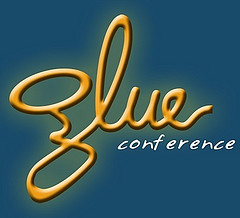 I’ve discussed earlier how Defrag was the best Conference I attended for quite a while. The conference Theme, sessions, very active participants, the venue, the infrastructure (working wi-fi, no small feat!) – you name it, it all came together perfectly. So when Defrag’s organizer, Eric Norlin sets out to launch another conference discussing all of the above and more, it’s bound to be a success. Here’s Eric’s summary:
I’ve discussed earlier how Defrag was the best Conference I attended for quite a while. The conference Theme, sessions, very active participants, the venue, the infrastructure (working wi-fi, no small feat!) – you name it, it all came together perfectly. So when Defrag’s organizer, Eric Norlin sets out to launch another conference discussing all of the above and more, it’s bound to be a success. Here’s Eric’s summary:Glue is the only conference devoted solely to solving the web application integration problem-set. People that should attend Glue include the architects, developers, administrators and integrators that have moved past the initial step of seeing the web as a platform, and are facing the real-world challenges of what "stove-piped" web applications mean for their overall strategy. Glue is about all of bits and pieces, APIs and meta-data, standards and connectors that will help us to glue together the varying applications of the new platform.
The Agenda is shaping up, Sponsors are in, and reservations are coming through nicely, recession or not. Like I’ve said, Some Conferences Are Worth Attending Even in Bad Times.

Of course getting a bargain helps in bad times: where else do you get an intense top-notch conference for $395? That is if you catch early bird reservation, so hurry, get sticky now.
By the way, participation does not start in May – you can share ideas right now, I’ll help with resources. CloudAve, my main blogging gig is pleased to be the Media Sponsor for Glue, and you will see a stream of related posts over there as we approach the Conference dates (this may be the right time to grab the CloudAve Feed). We invite everyone interested to participate: please submit your post, we’ll be happy to publish it. And if you prefer to post in your own blog, wiki, Twitter, FriendFeed, Facebook…whatever – just make sure to use the tag gluecon (since glue might find – you know, this). We’ll find your post and pull it under the Glue Tab, which will soon turn into a resource list of all-things-glue.
On a personal level I am stoked to be able to serve on the Glue Conference‘s Advisory Board along with great thinkers like Amy Wohl, Phil Wainewright, Chris Shipley, Mike West, and Albert Wenger. I’m really excited about this Conference, and am looking forward to meeting many of you.
What are you waiting for? Get Sticky Now!

(Cross-posted from CloudAve)

Under the Radar: Call for Startups in Cloud Computing & Business Applications
 Under the Radar is the Silicon Valley’s most established startup debut platform: a conference series organized by Dealmaker Media, covering business applications, social media, entertainment, mobility..etc.
Under the Radar is the Silicon Valley’s most established startup debut platform: a conference series organized by Dealmaker Media, covering business applications, social media, entertainment, mobility..etc.
The 11th Under the Radar conference in Mountain View, CA on April 24, 2009 will focus on Cloud Computing and Business Applications and the organizers have issued a CALL FOR COMPANIES to present.
The general criteria for all UTR events:
- Unique value proposition
- Ability to monetize product/business
- Large market opportunity
- Must still be considered "under the radar" – launched in 2008
- Company must be an actual startup – not a new product from a large company
Typically 32 finalists are selected, who will present in a rapid-fire format – they are grouped in categories of 4 each, in two parallel tracks and each presenter has about 15 minutes. They get grilled by the judges and audience, and at the end of the conference the winners of each category are announced. Categories for the April event are:
- Cloud Infrastructure
- Platforms
- Virtualization
- Saas
- Mashups
- Collaboration
- Communication
- Business Apps
- Development Tools (Utilities, OS, etc…)
- Mobile Office
- Semantics
- Commerce
- Social software/ networks
- Sync (online/offline)
If you’re building a startup, meet the criteria above, will have a real product / service out by April, don’t hesitate: APPLY.
See you in April!
(Cross-posted from CloudAve – to stay on top of Cloud Computing news, analysis and just our opinion, grab the CloudAve Feed here)

Google Releases Zoho Mail with Offline Support
Yes, you read it right: the first announcement of Zoho Mail’s general availability, with Google Gears-based offline support did not come from Zoho, but from the Google Gears team, which released this video discussing Zoho’a use of Google Gears, synchronization, the Marketplace and a lot more a bit prematurely:
Somewhat used to it (see TechCrunch Releases New Zoho Service: Invoice) the Zoho folks decided to play along and released their own announcement.
This announcement somewhat symbolizes the interesting dynamics between Zoho and Google: competitors, yet collaborators. ReadWriteWeb is probably right:
But also Google probably sees Zoho less as a competitor at this point (even though Zoho does compete directly against Google Apps) and more as an evangelist for its technology – such as Google Gears.
First of all what’s in today’s announcement:
- Zoho Mail has been in private beta for over a year now. As much as we like to switch to native collaboration using web-based tools, email is still where most productivity workers spend 80+% of their time. Mail is the glue that brings it all together – so it’s important for Zoho to step out of background testing mode and make Mail publicly available. It’s also an integral part of the Zoho Business Suite.
- Features: It’s an email service (everyone gets a user@zoho.com email account) and an email program that can consolidate several other email accounts, Outlook-style. It combines old and new: supports hierarchical folders a’la Outlook as well as Gmail-style labels, chronological view as well as the threaded conversation views made popular by Gmail.
- Access anywhere, any time: Offline access is provided via Google Gears (for now Firefox and IE only), and it’s also available on the iPhone.
- Integrated Chat – this is another “glue” application within the Zoho Suite, and several other features listed here.
So with all that, why am I unhappy? I’m a die-hard Gmail fan, mostly for its productivity boosting features:
- Conversation threads
- Labels
- Search
Zoho Mail handles the latter two well, but I am not too happy with the way conversation threading works. My business conversations last weeks, include dozens of emails, and on a traditional mail system the threads are basically a pain to put together before responding to someone. Gmail handles it automagically, and as a side-effect, it presents a lot more information on it’s list screen – since the dozen individual emails are now compressed into one line.
But we all have different usage patterns. When debating the importance of threads, I looked at other Zoho Mail users whose conversations are typically one-off, so they won’t value threading feature at all. In fact not everyone needs productivity. Not everyone wants to go through a paradigm change.
AOL, YAHOO, Hotmail are the absolute web-mail market leaders,and they should do whatever it takes to keep their customers. Their mainstream users are corporate employees who use Outlook in the Office, whether they like it or not is irrelevant, they are used to it. When they go home, they may not email a lot. Some will check their emails daily, once a week, or less. They want a personal email that resembles to what they already know. For them familiarity is more important than productivity.
As much as I hate to admit it, I am NOT the mainstream Zoho customer. I am probably more a part of the TechCrunch 53,651 (even though it’s 1M now) than the mainstream customer base Zoho targets. And if it wasn’t clear before, the current crisis brought home the message loud and clear: only businesses with real revenues survive. Which probably means that for all my yelling and screaming, Zoho is quite right coming out with an email system that meets the needs of businesses who actually pay for it. After all, this is what enables them to offer all the other apps I like for free. And I like free. 
(Disclosure: I’ve been a long-time Advisor to Zoho and they are exclusive sponsor of my main gig, CloudAve. This article has been cross-posted there.)
Related articles by Zemanta
- Zoho Mail now online – and offline thanks to Google Gears
- Zoho Mail Gets Offline Support via Google Gears – Ahead of Gmail
- Zoho Mail: Now With Offline and Mobile Support
- Zoho Mail: Mobile, offline, and out of beta


Email is Still Not Dead, and Won’t Be For a While
I can’t believe the email is dead theme, popped up again, this time on SocialMediaToday, originally on OnlineMarketerBlog. I responded in detail on CloudAve.
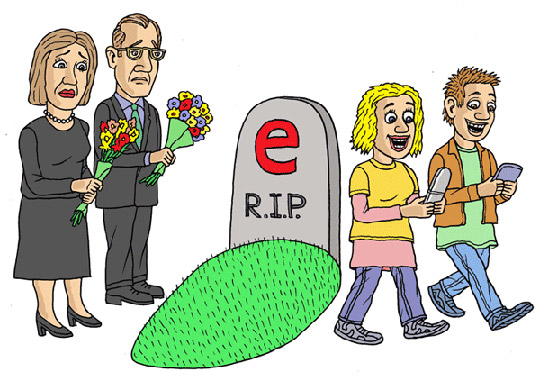
Image credit: CrunchGear.

Oh, That Bloated Presentation – The Web is Greener
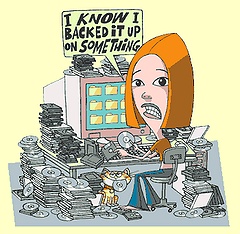 We can argue all we want about the benefits of SaaS, discuss hypothetical use cases at length, but the best showcases are served up by real life, often unexpectedly.
We can argue all we want about the benefits of SaaS, discuss hypothetical use cases at length, but the best showcases are served up by real life, often unexpectedly.
A startup CEO friend asked me to take a look at his PowerPoint deck before he would send it to a VC. (Incidentally, I don’t believe presentations should be sent in advance of a meeting: if your deck has enough content to convey the message standalone, than it’s not a presentation… but let’s put that aside for now.) I agreed to help, and he fired off an email with the PPT attachment.
Too bad I could not open it. I have MS Office 2003 on my Windows computer – that’s the last version I purchased, since moving to the Cloud, and I won’t buy an Office package ever again – and he has Office 2008 on his shiny Macbook Air. (Standard issue for hot startup CEO’s in San Francisco?). Yes, I know there’s a converter thingie I can download from MS, but apparently I haven’t done it on this particular computer, so my friend quickly saved it for me in the older format.
I reviewed and commented on it, and as an aside noted that the fonts and the text alignment were way off on a page. He did not see the text problem on the version I sent back. Then came a second round of conversions and emails. It became apparent that no matter what we do we always end up seeing different layouts – so much for the MS to MS conversion – so we just focused on content, and I sent back the revised version. It took a while… hm, no wonder, the PPT deck that started it’s life as a 2MB file first became 5, then 7, finally 9 Megabytes. Wow!
What an inefficient process! Emailing multiple bloated copies of the same file, never seeing the identical version, leaving quite some footprint behind, when we could have started with an online presentation, collaboratively work on the one and only copy online, see the same and not clutter several computers with the garbage files.
I will come back to this in a minute, but here’s another benefit my CEO friend missed out on: providing the latest and greatest information. The VC Partner he was talking to was about to to go on vacation, and she was planning to review the presentation in the next 2 weeks – who knows when. This startup was at the time in advanced discussion with major prospects, and signing any of those deals would materially change the presentation. Had my friend sent just a URL to the online presentation, he could have safely update it any time, and be assured that whenever the VC reviews it, she will always have the latest and greatest information. Does this scenario ( sans the VC) sound familiar? How many times have you hit “send” only to wish you could retract the email and replace the attachment with the correct version?
Back to the storage footprint issue. On my count, just between my friend and myself, we generated and stored nine copies of this presentation, the last one being 9MB, up from 2. It’s probably fair to assume a similar rate of multiplication in the process the original deck was created, between the CEO and his team. Next he sends it to the VC, who will likely share it with several Associates in the firm, and in case there’s more interest, with other partners. Of course my friend will send the same presentation to a few other VC firms as well, so it’s not beyond reasonable to think that there are at least a hundred copies floating around, occupying a Gigabyte of storage or more. Oh, and I did not even consider the footprint of this presentation at ISP’s and all hops it goes through. Not that I ever bought into IDC’s Storage Paradox, but this is clearly a very wasteful process.
All of that could be replaced with one central copy on the Web, represented by a URL.
Oh, and the irony of all this: my friend is CEO of a GreenTech startup. 
(Cross-posted from CloudAve. Follow our CloudAve Feed for more)

3-year Old Millionaires
![]() No, not talking about babies here, but two Tech icons who both reached the Million milestone around their third birthday.
No, not talking about babies here, but two Tech icons who both reached the Million milestone around their third birthday.
TechCrunch, launched 3-year ago as Mike Arrington’s hobby blog had 1 million Feedburner subscribers for the first time last week. Of course it’s no longer a hobby blog, but a blog network run by a professional CEO, supported by a growing blogger team. Mike himself has become a Silicon Valley institution, his Atherton home Web 2.0 Central.
Congratulations, Mike! And Congrat’s to the other 3-year old millioinaire: Zoho.
When Zoho Writer launched three years ago it was the underdog compared to Writely (which later became Google Docs). But it improved week by week, was soon joined by Zoho Sheet, and one had to be blind not to  see the benefits of a complete Suite on the Net. Today Zoho has a million users, is recognized as a leader along with Google, has made inroads to the Enterprise (400K users at GE? Not bad…), The Economist calls them the force that will Deflate IT… a lot of achievements in three years.
see the benefits of a complete Suite on the Net. Today Zoho has a million users, is recognized as a leader along with Google, has made inroads to the Enterprise (400K users at GE? Not bad…), The Economist calls them the force that will Deflate IT… a lot of achievements in three years.
Once again, congratulations to both… and now the race is on: who will reach the 2 Million mark first? 

Office 2.0, a Most Irregular Conference – Get Your Discount Here

Nothing about the Office 2.0 Conference is even remotely ordinary.
Start with the organizer, Ismael Ghalimi, CEO of a VC-funded startup, Intalio. That’s normally a full-time job – not when it comes to Ismael: he is also a scuba-diving instructor, a pilot, launched Monolab|Workspace, (is that Incubator 2.0?), launched the Extreme Productivity Seminar series, oh, and have I mentioned the annual Office 2.0 Conference? ( I actually know his secret, he has two body doubles, I just haven’t been able to prove it yet )
)
Pressed for time he is turning a necessity into a virtue: year by year the Conference is a showcase of creating a successful event out of nothing in only two months. I remember the first event in 2006, when a couple of us Enterprise Irregulars were helping him plan the sessions only weeks away from the start. A few days and a few blog posts later Ismael got flooded with request for sponsor and speaking slots. This year history repeats itself: just a month ago the conference site was a placeholder and one could only wonder if … then a new site was born overnight, based on Jive Software’s excellent ClearSpace platform, and now it’s alive with user participation, sponsors, registration..etc.
What’s a Web-focused Conference without wi-fi? It’s a joke that in 2008 conferences, including brands like Web 2.0, Gnomedex …etc. still fail to provide sufficient connection. Ismael’s solution includes laser beams to the top of the building, another one down to a terrace, then inside – making it happen with Swisscom was quite a project in itself. Office 2.0 set the standard once and for all, anything less at major conferences is a failure.
 Then there’s the issue of The Gadget. I believe the iPod at the first conference was just more-then-generous swag. The iPhones handed out at the second conference had an integral part at the event: several applications released specifically for Office 2.0 allowed participants to interact with each other, navigate the schedule and find sessions. This time all paid participants will receive a the HP 2133 Mini-Note PC.
Then there’s the issue of The Gadget. I believe the iPod at the first conference was just more-then-generous swag. The iPhones handed out at the second conference had an integral part at the event: several applications released specifically for Office 2.0 allowed participants to interact with each other, navigate the schedule and find sessions. This time all paid participants will receive a the HP 2133 Mini-Note PC.
Yes, the conference swag is not pens, stickers or t-shirts: it’s a mini-computer, which cost about half the registration fee. It will clearly raise eyebrows, and many would prefer to skip the gadget and pay reduced fees. I think handing out such an expensive gadget will have an interesting effect on the conference demographic: we’ll likely see an increase of corporate employees, who can expense the entire conference and are less price-sensitive than startups and freelancers – the original Office 2.0 crowd.
But that may very well be what the conference needs. There’s a reason why this year’s theme is Enterprise Adoption. The Office 2.0 movement wouldn’t go very far with only the early pioneers, evangelists talking to themselves, dissmissing enterprise requirements. For the principles to become practice in business, we need a more balanced mix, and in a twisted way the gadget may just help achieve that.
Those who can’t afford the full registration are not entirely locked out: Socialtext CEO and top evangelist Ross Mayfield will facilitate Un-Conference 2.0 the day before the official conference, at a cost of $50.
Finally, startups have a chance to present the attending VCs, media, bloggers at LaunchPad – Ismael announced this event over the weekend, and already has 10 particpants – get in there while you can. Note to my (numerous) VC readers: I hope you will be there, too.
If you’re still hesitating, check out the Agenda, the list of Speakers, Media representatives, and if you haven’t done so, register now.
I’ve saved the best for last: don’t use the standard registration, save $100 by registering here.
Update: while I was typing here, fellow Enterprise Irregular Dennis Howlett explained why this is an Irregular (pun intended) Conference in more than one way. Update to the update: see Susan’s excellent summary.
(cross-posted on the Conference Blog)

Sync Update: Syncplicity, Dropbox, Windows Live (?) Mesh
 Quick update to my recent Syncplicity review:
Quick update to my recent Syncplicity review:
In the meantime Microsoft’s Windows Live Mesh opened to the public, combining synhcronization and backup – also competing with their own Foldershare. Now a word on what will happen to Foldershare, but I guess the writing is on the wall. That said, Live Mesh just failed for me the second time, so I can’t really recommend it.
Another service, Dropbox is getting a lot of buzz nowadays, largely to a smart theme of giving out limited numbers of beta invitations. Apparently artificially created shortage is good marketing, bloggers LOVE being able to give away 10 or so invites…
 Dropbox has one advantage over Syncplicity: it’s multi-platform, including Apple’s OS X and Linux, whereas Syncplicity is Windows only for now. But that’s where it ends: it has less features (forget Web Apps integration, e.g. Google, Zoho, Scribd, Picnik), and has what I consider a huge flaw: you have to drop your files into a dedicated folder to be synchronized. That may be reasonable if you want to collaborate on a limited set of files, but it simply does not resolve the “access to all my data anywhere, anytime” problem. It’s certainly a show-stopper for me.
Dropbox has one advantage over Syncplicity: it’s multi-platform, including Apple’s OS X and Linux, whereas Syncplicity is Windows only for now. But that’s where it ends: it has less features (forget Web Apps integration, e.g. Google, Zoho, Scribd, Picnik), and has what I consider a huge flaw: you have to drop your files into a dedicated folder to be synchronized. That may be reasonable if you want to collaborate on a limited set of files, but it simply does not resolve the “access to all my data anywhere, anytime” problem. It’s certainly a show-stopper for me.
So if you’re waiting for a Dropbox invitation, you might as well try Syncplicity – you’ll love it. And if you sign up here, you get 1G more, i.e. 3G of free storage instead of the standard 2G.
Update: I received a very good, constructive comment from Assaf, who pointed out this was a largely negative post. In my mind this post is an extension of my original Syncplicity review, but now that I re-read it on it’s own, I agree with Assaf. Please read my response here, that makes this post complete.

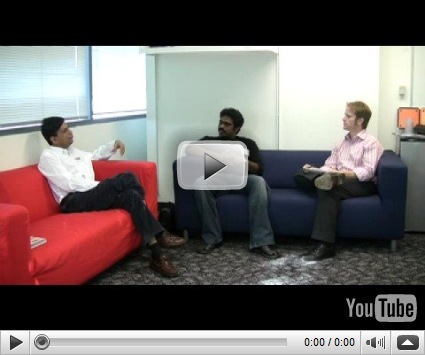
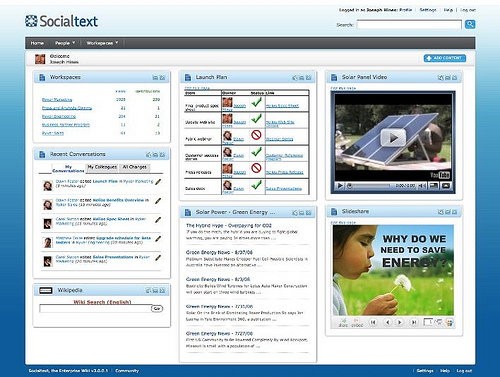



Recent Comments